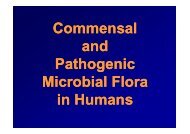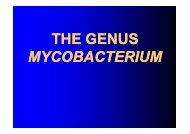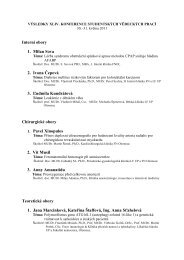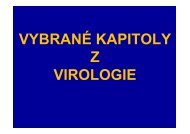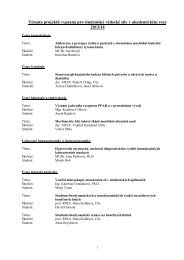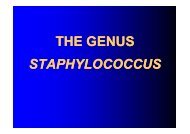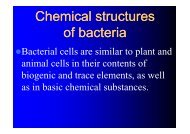PATHOGENESIS OF BACTERIAL INFECTION - LF
PATHOGENESIS OF BACTERIAL INFECTION - LF
PATHOGENESIS OF BACTERIAL INFECTION - LF
Create successful ePaper yourself
Turn your PDF publications into a flip-book with our unique Google optimized e-Paper software.
<strong>PATHOGENESIS</strong><br />
<strong>OF</strong><br />
<strong>BACTERIAL</strong> <strong>INFECTION</strong><br />
PATHOGENICITY<br />
TOXIGENICITY<br />
VIRULENCE
The pathogenesis of bacterial infection<br />
includes the initiation of the infectious<br />
process and the mechanisms leading to<br />
the development of signs and symptoms<br />
of bacterial disease.<br />
The outcome of the interaction between<br />
The outcome of the interaction between<br />
bacteria and host is determined by<br />
characteristics that favour establishment<br />
of the bacteria within the host and their<br />
ability to damage the host as they are<br />
opposed by host defense mechanisms.
Among the characterics of bacteria<br />
are adherence to host cells,<br />
invasiveness, toxigenity, and ability to<br />
evade the host s immune system.<br />
If the bacteria or immunological<br />
reactions injure the host sufficiently,<br />
disease becomes apparent.
Pathogenesis<br />
of bacterial infection<br />
Humans and animals have abundant normal<br />
microflora.<br />
Most bacteria do not produce disease but<br />
achieve a balance with the host that ensures<br />
the survival, growth, and propagation of both<br />
the bacteria and the host.<br />
Sometimes bacteria that are clearly pathogens<br />
(e.g. Salmonella typhi) are present, but infection<br />
remains latent or subclinical and the host is a<br />
"carrier" of the bacteria.
It can be difficult to show that a specific<br />
bacterial species is the cause of a particular<br />
disease.<br />
In 1884, Robert Koch proposed a series of<br />
postulates in his treatise on Mycobacterium<br />
tuberculosis and tuberculosis.<br />
These postulates have been applied more<br />
broadly to link many specific bacterial species<br />
with particular diseases.
Koch s postulates are summarized as follows:<br />
The microorganism should be found in all cases of the<br />
disease in question, and its distribution in the body<br />
should be in accordance with the lesions observed.<br />
The microorganism should be grown in pure culture in<br />
vitro (or outsite the body of the host) for several<br />
generations.<br />
When such a pure culture is inoculated into<br />
susceptible animal species, the typical disease must<br />
result.<br />
The microorganism must again be isolated from the<br />
lesions of such experimentally produced disease.
Koch s postulates remain a<br />
mainstay of microbiology<br />
However, since the late 19th century, many<br />
microorganisms that do not meet the criteria of<br />
the postulates have been shown to cause<br />
disease.<br />
For example, Treponema pallidum (syphilis)<br />
and Mycobacerium leprae (leprosy) cannot be<br />
grown in vitro, but there are animal models of<br />
infection with these agents.
In another example, Neisseria gonorrhoeae<br />
(gonorrhea),<br />
there is no animal model of<br />
infection even though the bacteria can readily<br />
be cultivated in vitro.<br />
The host s immune responses should be<br />
considered when an organism is being<br />
investigated as the possible cause of a disease.<br />
Thus, development of a rise in specific antibody<br />
during recovery from disease is an important<br />
adjunct to Koch s postulates.
Modern-dayday microbial genetics has opened new<br />
frontiers to study pathogenic bacteria and differentiate<br />
them from non-pathogens.<br />
The ability to study genes associated with virulence<br />
has led to a proposed of Koch´s postulates:<br />
The phenotype, or property, under investigation<br />
should be associated with pathogenic members of a<br />
genus or pathogenic strains of a species.<br />
Specific inactivation of the gene(s) associated with the<br />
suspected virulence trait should lead to a measurable<br />
loss in pathogenicity or virulence.<br />
Reversion or allelic replacement of the mutated gene<br />
should lead to restoration of pathogenicity.
Analysis of infection and disease through the<br />
application of principles such as Koch s postulates<br />
leads to classification of bacteria as pathogenic or<br />
non-pathogenic.<br />
Some bacterial species are always considered to be<br />
pathogens, and their presence is abnormal.<br />
– Examples include Mycobacterium tuberculosis<br />
(tuberulosis) and Yersinia pestis (plague).<br />
– Other species are commonly part of the normal flora<br />
of humans (and<br />
animals) but can also frequently<br />
cause disease. For example, Escherichia coli is part<br />
of the gastrointestinal flora of normal humans, but it<br />
is also a comon cause of urinary tract infection,<br />
traveller s diarrhea, and other diseases.
The infectious process<br />
Infection indicates multiplication of<br />
microorganisms.<br />
Prior to multiplication, bacteria (in case of<br />
bacterial infection) must enter and establish<br />
themselves within the host.<br />
The most frequent portals of entry are the<br />
respiratory (mouth<br />
and nose), gastrointestinal,<br />
and urogenital tracts. Abnormal areas of<br />
mucous membranes and skin (e.g. cuts, burns)<br />
are also frequent sites of entry.
The infectious process<br />
Once in the body, bacteria must attach or<br />
adhere to host cells, usually epithelial cells.<br />
After the bacteria have established a primary<br />
site of infection, they multiply and spread.<br />
Infection can spread directly through tissues or<br />
via the lymphatic system to bloodstream.<br />
Bloodstream infection (bacteremia) can be<br />
transient or persistent. Bacteremia allows<br />
bacteria to spread widely in the body and<br />
permits them to reach tissues particularly<br />
suitable for their multiplication.
The infectious process<br />
As an example of the infectious process, Streptococcus<br />
pneumoniae can be cultured from the nasopharynx of 5-40% of<br />
healthy people.<br />
Occasionally, S. pneumoniae strains from the nasopharynx are<br />
aspirated into the lungs. Infection develops in the terminal air<br />
space of the lungs in persons who do not have protective<br />
antibodies against that type of S. pneumoniae. Multiplication of<br />
S. pneumoniae strains and resultant inflammation lead to<br />
pneumonia. The strains then enter the lymphatics of the lung<br />
and move to the bloodstream. Between 10% and 20% of<br />
persons with S. pneumoniae pneumonia have bacteremia at<br />
the time the diagnosis of pneumonia is made. Once bacteremia<br />
occurs, S. pneumoniae strains can spread to their preferred<br />
secondary sites of infection (e.g. cerebrospinal fluid, heart<br />
valves, joint spaces). The major resulting complications of S.<br />
pneumoniae pneumonia include meningitis, endocarditis and<br />
septic arthritis.
Basic terms frequently used in<br />
describing aspects of pathogenesis:<br />
Infection<br />
– Multiplication of an infectious agent within the<br />
body.<br />
– Multiplication of the bacteria that are part of<br />
normal flora of gastrointestinal tract, skin, etc,<br />
is generally not considered an infection.<br />
– On the other hand, multiplication of<br />
pathogenic bacteria (e.g. Salmonella<br />
species), even if the person is asymptomatic,<br />
is deemed an infection.
Basic terms frequently used in<br />
describing aspects of pathogenesis:<br />
Pathogenicity<br />
– The ability of an infectious agent to cause disease.<br />
Virulence<br />
– The quantitative ability of an agent to cause<br />
disease.<br />
– Virulent agents cause disease when introduced into<br />
the host in small numbers.<br />
– Virulence involves invasiveness and toxigenicity.
Basic terms frequently used in<br />
describing aspects of pathogenesis:<br />
Toxigenicity<br />
– The ability of a microorganism to produce a toxin<br />
that contributes to the development of disease.<br />
Invasion<br />
– The process whereby bacteria, parasites, fungi and<br />
viruses enter the host cells or tissues and spread in<br />
the body.
Basic terms frequently used in<br />
describing aspects of pathogenesis:<br />
Pathogen<br />
– A microorganism capable of causing disease.<br />
Non-pathogen<br />
– A microorganism that does not cause disease. It may be part<br />
of the normal flora.<br />
Opportunistic pathogen<br />
– An agent capable of causing disease only when the host s<br />
resistance is impaired (e.g. the patient is<br />
immunocompromised).<br />
– An agent capable of causing disease only when spread from<br />
the site with normal bacterial microflora to the sterile tissue<br />
or organ.
Bacterial virulence factors<br />
Many factors determine the<br />
virulence of bacteria, or their<br />
ability to cause infection and<br />
disease.
Toxins<br />
Toxins produced by bacteria are<br />
generally classified into two<br />
groups:<br />
–exotoxins<br />
–endotoxins
Endotoxins of<br />
gram-negative<br />
bacteria<br />
The endotoxins of gram-negative bacteria<br />
are complex lipopolysaccharides derived<br />
from bacterial cell walls and are often<br />
liberated when the bacteria lyse.<br />
The substances are heat-stable and can<br />
be extracted (e.g. with phenol-water).
Pathophysiological effects of<br />
endotoxins are similar regardless<br />
of their bacterial origin:<br />
–fever<br />
–leukopenia<br />
–hypotension<br />
–impaired organ perfusion and acidosis<br />
–activation of C3 and complement cascade<br />
–disseminated intravascular coagulation<br />
(DIC)<br />
–shock, death
Exotoxins<br />
Many gram-positive and gramnegative<br />
bacteria produce exotoxins<br />
of considerable medical importance.<br />
Some of these toxins have had major<br />
role in world history (e.g. toxin of<br />
Clostridium tetani).
Diphtheria toxin<br />
(toxin of Corynebacterium diphtheriae)<br />
Corynebacterium diphtheriae strains that<br />
carry a temperate bacteriophage with the<br />
structural gene for the toxin are toxigenic<br />
and produce diphtheria toxin.<br />
This native toxin is enzymatically<br />
degraded into two fragments: A and B,<br />
linked together by a disulfide bound. Both<br />
fragments are necessary for toxin activity.
Tetanospasmin (toxin of Clostridium tetani)<br />
Clostridium tetani is an anaerobic gram-positive rod that is<br />
widespread in the environment.<br />
Clostridium tetani contaminates wounds, and the spores<br />
germinate in the anaerobic environment of the devitalized<br />
tissue. The vegetative forms of Clostridium tetani produce<br />
toxin tetanospasmin. The released toxin has two peptides<br />
linked by disulfide bounds. Toxin reaches the central<br />
nervous system by retrograde transport along axons and<br />
through the systemic circulation. The toxin acts by<br />
blocking release of an inhibitory mediator in motor neuron<br />
synapses. The result is initially localized then generalized,<br />
muscle spasms. Extremely small amount of toxin can be<br />
lethal for humans.
Botulotoxin (toxin of Clostridium botulinum)<br />
Clostridium botulinum is found in soil or water and may<br />
grow<br />
in foods<br />
if<br />
the environment<br />
is appropriately<br />
anaerobic.<br />
An exceedingly potent toxin (the<br />
most potent toxin known)<br />
is produced by Clostridium botulinum strains. It is heat-<br />
labile and is destroyed by sufficient heating. There are<br />
eight disctinct serological types of toxin. Types A, B and E<br />
are most commonly associated wih human disease. Toxin<br />
is absorbed from the gut and carried to motor nerves,<br />
where it blocks the release of acetylcholine at synapses<br />
and neuromuscular junctions. Muscle contraction does not<br />
occur, and paralysis results.
Toxins of<br />
Clostridium perfringens<br />
Spores of Clostridium perfringens are introduced<br />
into the wounds by contamination with soil or<br />
faeces. In the presence of necrotic tissue (an<br />
anaerobic environment),<br />
spores germinate and<br />
vegetative cells produce several different toxins.<br />
Many of these are necrotizing and hemolytic and<br />
favour the spread of gangrene:<br />
– alpha toxin is a lecithinase that damages cell<br />
membranes<br />
– theta toxin also has a necrotizing affect<br />
– and other
Streptococcal erythrogenic toxin<br />
Some strains of hemolytic lysogenic<br />
streptococci produce a toxin that results in<br />
a punctate maculopapular erythematous<br />
rash, as in scarlet fewer.<br />
Production of erythrogenic toxin is under<br />
the genetic control of temperate<br />
bacteriophage. If the phage is lost, the<br />
streptococi cannot produce toxin.
Toxic shock syndrom toxin - 1<br />
(TSST-1)<br />
Some Staphylococcus aureus strains growing on<br />
mucous membranes (e.g.. on the vagina in<br />
association with menstruation),<br />
or in wounds,<br />
elaborate TSST-1.<br />
This toxin is associated with toxic shock syndrome.<br />
The illness is characterized by shock, high fewer,<br />
and a diffuse red rash that later desquamates,<br />
multiple other organs systems are involved as well.
Exotoxins associated with<br />
diarrheal diseases<br />
Vibrio cholerae toxin<br />
Staphylococcus aureus enterotoxin<br />
Other enterotoxins - enterotoxins are also<br />
produced by some strains of:<br />
– Yersinia enterocoliticaerocolitica<br />
– Vibrio parahaemolyticus<br />
– Aeromonas species
Enzymes<br />
Many species of bacteria produce enzymes that are not<br />
intrinsically toxic but play important role in the infectious<br />
process.<br />
Collagenase<br />
– degrades collagen, the major protein of fibrous<br />
connective tissue, and promotes spread of infection in<br />
tissue.<br />
Coagulase<br />
– Staphylococccus aureus produce coagulase, which<br />
works in conjuction with serum factors to coagulate<br />
plasma. Coagulase contributes to the formation of fibrin<br />
walls around staphylococcal lesions, which helps them<br />
persist in tissues.
Hyaluronidases<br />
Enzymes<br />
– enzymes that hydrolyze hyaluronic acid, a constituent of<br />
the ground substance of connective tissue. They are<br />
produced by many bacteria (e.g. staphylococci,<br />
streptococci and anaerobes) and aid in their spread<br />
through tissues.<br />
Streptokinase<br />
– many hemolytic streptococci produce streptokinase<br />
(fibrinolysin),<br />
substance that activates a proteolytic<br />
enzyme of plasma. This enzyme, also called<br />
fibrinolysin, is then able to dissolve coagulated plasma<br />
and probably aids in the spread of streptococci through<br />
tissues. Streptokinase is used in treatment of acute<br />
myocardial infarction to dissolve fibrin clots.
Enzymes<br />
Hemolysins and leukocidins<br />
– Many bacteria produce substances that are<br />
cytolysins - they dissolve red blood cells<br />
(hemolysins<br />
hemolysins) or kill tissue cells or leukocytes<br />
(leukocidins).<br />
– Streptolysin O, for example, is produced by<br />
group A streptococci and is letal for mice and<br />
hemolytic for red blood cells from many<br />
animals.
Antiphagocytic factors<br />
Many bacterial pathogens are rapidly killed once they<br />
are ingested by polymorphonuclear cells or<br />
macrophages.<br />
Some pathogens evade phagocytosis or leukocyte<br />
microbidical mechanisms by adsorbing normal host<br />
componets to their surfaces.<br />
For example, Staphylococcus aureus has surface<br />
protein A, which binds to the Fc portion of IgG. Other<br />
pathogens have surface factors that impede<br />
phagocytosis<br />
e.g. Streptococcus pneumoniae and<br />
many other bacteria have polysaccharide capsules.
Adherence factors<br />
Once bacteria enter the body of the host, they<br />
must adhere to cells of a tissue surface. If they<br />
do not adhere, they would be swept away by<br />
mucus and other fluids that bathe the tissue<br />
surface.<br />
Adherence (which<br />
is only one step in the<br />
infectious<br />
process) is followed by development<br />
of microcolonies and subsequent complex<br />
steps in the pathogenesis of infection.
Adherence factors<br />
The interactions between bacteria and<br />
tissue cell surfaces in the adhesion<br />
process are complex.<br />
Several factors play important role:<br />
–surface<br />
hydrophobicity<br />
–binding<br />
molecules on bacteria and host<br />
cell receptor interaction<br />
–and<br />
other





